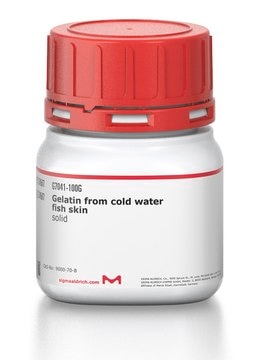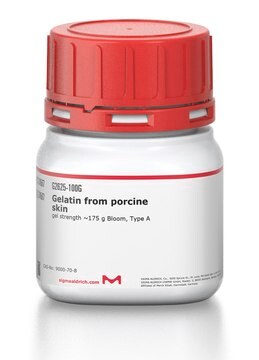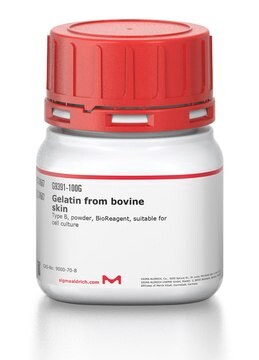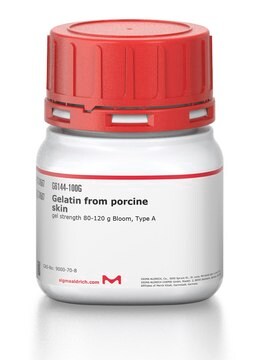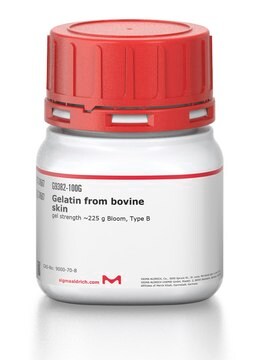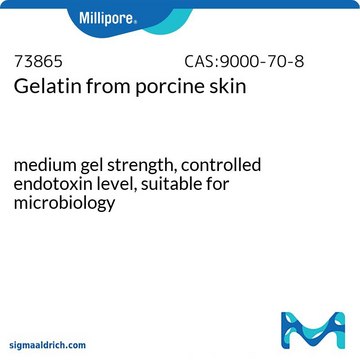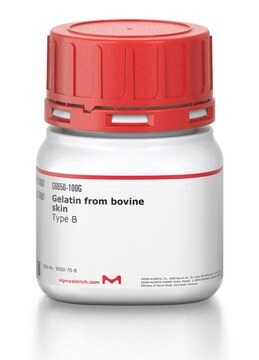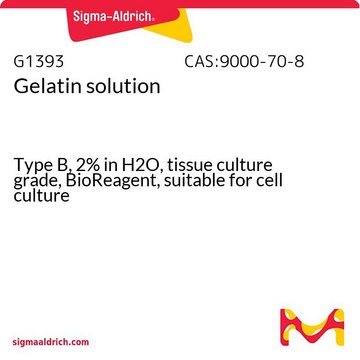39465
Gelatina
suitable for microbiology, ultrahigh gel strength
Autenticatiper visualizzare i prezzi riservati alla tua organizzazione & contrattuali
About This Item
Prodotti consigliati
Origine biologica
Porcine
Livello qualitativo
Forma fisica
powder
Qualità
ultrahigh gel strength
Durata
limited shelf life, expiry date on the label
Perdita
9.5-12.5% loss on drying
Trasmittanza
450 nm, ≥85%
620 nm, ≥95%
pH
5.20-5.60
Conducibilità
120-190 μS/cm at 30 °C (1%)
Viscosità
5.10-5.80 mPa.s
Resistenza del gel
280-302 g BloomAOAC
Solubilità
H2O: 67 mg/mL at 60 °C
Cationi in tracce
Ca: ≤100 mg/kg
applicazioni
microbiology
Cerchi prodotti simili? Visita Guida al confronto tra prodotti
Applicazioni
This product is recommended for use as a cell culture substratum at 1-5 μg/cm2 or 0.5-50 μg/mL. The optimal concentration does depend on cell type as well as the application and research objectives.
Gelatin has been used in many applications. It has use in coating cell culture to improve attachment of cells, being added to PCR to stabilize Taq DNA, as a blocking reagent in Western blotting, ELISA, and immunochemistry, and as a component of media for species differentiation in bacteriology. As a biocompatible polymer, it has used as a delivery vehicle for release of active biomolecules and in generation of scaffolds for tissue engineering applications. In the pharmaceutical industry, geltan can be used as a suspending and encapsulating agent, among other applications.
Gelatin has been used in many applications. It has use in coating cell culture to improve attachment of cells, being added to PCR to stabilize Taq DNA, as a blocking reagent in Western blotting, ELISA, and immunochemistry, and as a component of media for species differentiation in bacteriology. As a biocompatible polymer, it has used as a delivery vehicle for release of active biomolecules and in generation of scaffolds for tissue engineering applications. In the pharmaceutical industry, geltan can be used as a suspending and encapsulating agent, among other applications.
Componenti
La gelatina è una miscela eterogenea di proteine solubili in acqua ad alta massa molecolare media, presente nel collagene. Le proteine si estraggono facendo bollire in acqua pelle, tendini, legamenti, ossa, ecc. adatti. La gelatina di tipo A deriva da tessuto trattato con acidi. Quella di tipo B da tessuto trattato con calce.
Avvertenza
Dry gelatin, when stored in airtight containers at room temperature, will remain unchanged for many years. When heated at 100°C in the presence of air, it swells becomes soft and disintegrates to a carbonaceous mass with evolution of pyridine bases and ammonia.
Nota sulla preparazione
This product is derived from porcine skin. Gelatin is soluble in hot than in cold water. It is practically insoluble in most organic solvents such as alcohol, chloroform, carbon disulfide, carbon tetrachloride, ether, benzene, acetone, and oils. The Bloom number, determined by the Bloom gelometer, is an indication of the strength of a gel formed from a solution of the known concentrat ion. The Bloom number is proportional to the average molecular mass. Bloom numbers of porcine skin Gelatin vary from 90 to 300 g. Manufactured by Gelita AG
Codice della classe di stoccaggio
11 - Combustible Solids
Classe di pericolosità dell'acqua (WGK)
nwg
Punto d’infiammabilità (°F)
Not applicable
Punto d’infiammabilità (°C)
Not applicable
Scegli una delle versioni più recenti:
Possiedi già questo prodotto?
I documenti relativi ai prodotti acquistati recentemente sono disponibili nell’Archivio dei documenti.
I clienti hanno visto anche
M V Nasekin et al.
Anesteziologiia i reanimatologiia, (1)(1), 59-60 (2013-07-03)
The article deals with skills improving problem of epidural anaesthesia with ultrasound control. Methods of gelatin spinal column model making, use and its economical side are discussed in the article.
Johno Breeze et al.
Journal of the Royal Army Medical Corps, 159(2), 84-89 (2013-05-31)
Ballistic gelatin is the most common tissue simulant used to reproduce the penetration of projectiles into muscle but published data to support its use are primarily based on bullets, despite explosive fragments being the most common cause of injury to
Takeo Furuya et al.
The journal of spinal cord medicine, 36(2), 134-139 (2013-07-03)
Besides stimulating angiogenesis or cell survival, basic fibroblast growth factor (bFGF) has the potential for protecting neurons in the injured spinal cord. To investigate the effects of a sustained-release system of bFGF from gelatin hydrogel (GH) in a rat spinal
Monica A Serban et al.
Methods in molecular biology (Clifton, N.J.), 1001, 133-143 (2013-03-16)
Tissue engineering involves the concerted action of biomaterials, cells, and growth factors. Kidney -regeneration relies on the same combination of ingredients. Here, we describe an example of gelatin-based biomaterial preparation and its evaluation in the context of kidney biocompatibility and
Nina E Lamash et al.
PloS one, 8(3), e58433-e58433 (2013-03-19)
Four proteases with molecular masses of 132, 58, 53, and 47 kDa were detected in the digestive system of the holothurian Eupentacta fraudatrix. These proteases displayed the gelatinase activity and characteristics of zinc metalloproteinases. The 58 kDa protease had similar
Il team dei nostri ricercatori vanta grande esperienza in tutte le aree della ricerca quali Life Science, scienza dei materiali, sintesi chimica, cromatografia, discipline analitiche, ecc..
Contatta l'Assistenza Tecnica.

